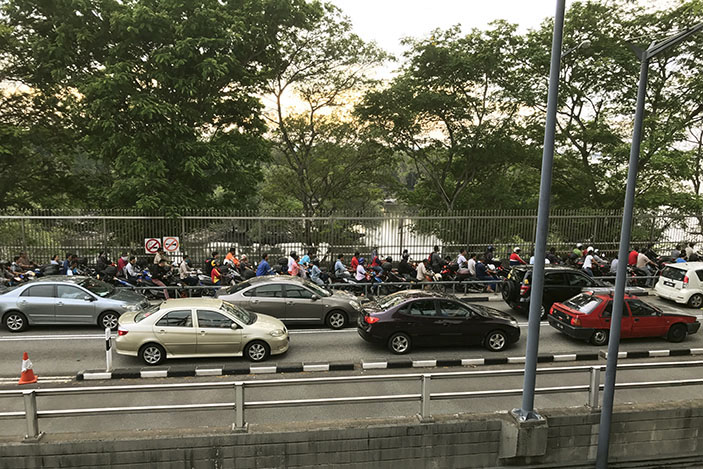AHEAD of the Easter long weekend, people going into Malaysia via the road links will have to brace themselves for the perennial jams — both vehicular and human — at the Singapore checkpoints.
These jams, especially at Woodlands, have been going on since Singapore gained independence. Singapore may have progressed, but the time taken to enter Singapore from the Causeway has regressed.
Perhaps it’s a consequence of Singapore’s progress that the checkpoints can’t keep up.
In December 2015, it was estimated that 400,000 people cross Singapore’s checkpoints daily, with the number increasing by tens of thousands during holiday periods. These numbers have likely grown since then, making it one of the busiest checkpoints in the world.
Over the years, there have been many solutions proposed and some implemented, but the problem persists.
It is fed by the strength of the Singapore Dollar relative to the Malaysian Ringgit. At more than three to one now, the exchange rate has enticed more blue-collar Malaysians to try to find work in Singapore, while Singaporeans head the other way to take advantage of the strong Singapore dollar in Malaysia.
Business is booming in Johor Bahru, with demand from Singapore visitors for goods and services raising the cost of living there, too.
If there was ever a urgent need for out-of-the-box thinking, it is to find solutions to the jams at the two road links between Singapore and Johor. However, no sense of urgency seems to be evident.
People Moving In Droves
At the government level, we hear of Singapore and Malaysian leaders convening committees to discuss the problem and find solutions, but such committees have exhibited little progress. Instead, we only see the sporadic implementation of taxes at both ends of the links.
In Singapore, the slow clearance is attributed to customs officers making thorough checks. Terrorist threats are uppermost in the mind of the Home Team and it is better to be safe than sorry when it comes to the island’s security.
However, it is puzzling that in this technological age, people have to wait up to three to four hours to be cleared. If it were just a matter of not having enough customs officers manning booths, then the obvious solution is to build and open more booths. But this also doesn’t seem to have much impact.
Hence, other solutions will have to be found and it is likely that these will have to leverage on new technologies. However, developments like biometrics-based identification mechanisms do not really speed up the queue.

One Clearance Point
One solution could be combined Singapore/Malaysia customs booths. This may be in the works with the high-speed rail and MRT link to Johor Bahru. This process will have to be tested ahead of the launch of these train services and could be a possibility for the Tuas and Woodlands links. But it will require political will on both sides to make it happen.
Legacy politics still weighs heavily on Singapore–Malaysia relations though there has been some progress on this front in recent years. Having one clearance point for both Singapore and Malaysia will save people a lot of time.
It should be stressed that the problem of jams between Singapore and Johor is not a trivial one that surfaces now and again. It is a daily occurrence during peak periods. Malaysians working in Singapore can’t go back to their families as quickly as they want and vice versa. For a nation that prides itself on efficiency and expedience, having Singaporeans waiting inordinate amounts of time in queues represents a huge opportunity cost.
You might also want to read:
The Unsettling Growing Wealth Disparity
Big Data Is The New Balance Sheet
Hazy Treatment For Jams?
It is possible that things could improve if the daily traffic jams are likened to the haze from Sumatra that has affected Singapore in recent years. There has always been an uproar at the highest levels in Singapore about the haze. A similar case can be made for traffic jams — why is there no uproar from the highest echelons of governance?
The idle time of delivery trucks, workers and tourists going both ways has an economic impact on both the Singapore economy and the Johor economy. Unlike the haze, which is spread over a huge area, the cause of the jams are highly localised and can be easily identified. Why can’t they be dealt with with the same level of seriousness?
There are those who say that people make their choice to work in Singapore or to shop in Malaysia. No one forces them to, so it is par for the course that they suffer the jams. It is hoped that Singapore society can shed this sort of backward thinking because it doesn’t help the citizenry. It only helps those who are meant to serve the citizens, by giving them an out on what should be an easily solvable problem.
Thus It Was Unboxed by One-Five-Four Analytics presents alternative angles to current events. Reach us at 154analytics@gmail.com





















